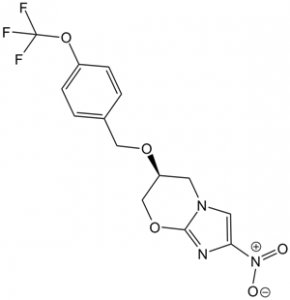This product is for research use only, not for human use. We do not sell to patients.

| Size | Price | Stock |
|---|---|---|
| 500mg | $990 | In Stock |
| 1g | $1550 | In Stock |
| 5g | $3900 | In Stock |
Cat #: V0011 CAS #: 187235-37-6 Purity ≥ 98%
Description: Pretomanid (also known as PA-824; PA824), a bicyclic nitroimidazolepyran analog, is a novel, potent and selective anti-tuberculosis (TB) drug approved in 2019 for treating multi-drug-resistant tuberculosis with an MIC of less than 2.8 μM. It is generally used together with bedaquiline and linezolid. PA-824 has been found to exhibit bactericidal activity against replicating bacilli and non-replicating bacilli under hypoxic or prolonged culture conditions in a dose dependent fashion through two possible mechanisms, which include PA-824 induced inhibition of ketomycolate synthesis and PA-824 mediated donation of nitric oxide during enzymatic nitro-reduction.
References: [1]. Stover CK, et al. A small-molecule nitroimidazopyran drug candidate for the treatment of tuberculosis. Nature. 2000 Jun 22;405(6789):962-6.
Publications Citing InvivoChem Products
Product Promise

- Physicochemical and Storage Information
- Protocol
- Related Biological Data
- Stock Solution Preparation
- Quality Control Documentation
| Molecular Weight (MW) | 359.26 |
|---|---|
| Molecular Formula | C14H12F3N3O5 |
| CAS No. | 187235-37-6 |
| Storage | -20℃ for 3 years in powder formr |
| -80℃ for 2 years in solvent | |
| Solubility In Vitro | DMSO: 72 mg/mL (200.4 mM)r |
| Water: <1 mg/mLr | |
| Ethanol: 16 mg/mL (44.5 mM) | |
| Solubility In Vivo | 0.5% methylcellulose: 30 mg/mL |
| SMILES Code | FC(F)(F)OC1=CC=C(C=C1)CO[C@H]2CN3C(OC2)=NC([N+]([O-])=O)=C3 |
| Synonyms | PA-824; Pretomanid; PA 824; PA824; |
| Protocol | In Vitro | In vitro activity: In vitro, PA-824 exhibits the high activity against multidrug-resistant clinical isolates from Asia (India and South Korea) and from throughout the United States (MIC < 1 μg/ml) and is equally active against the drug-sensitive and multidrug-resistant isolates of M. tuberculosis (MICs range, 0.039 to 0.531 μg/ml). A recent study shows that single-nucleotide polymorphisms of PA-824 resistance genes (fgd1 [Rv0407] and ddn [Rv3547]) don't significantly affect the PA-824 MICs (≤ 0.25 μg/ml). Kinase Assay: Pretomanid (PA-824) is a small-molecule nitroimidazopyran drug candidate for the treatment of tuberculosis; the MIC values of PA-824 against a panel of MTB pan-sensitive and rifampin mono-resistant clinical isolates ranged from 0.015 to 0.25 ug/ml. IC50 value: 0.015 to 0.25 ug/ml (MICs). Cell Assay: A method is used to determine the MICs by a microdilution plate assay by using M. tuberculosis H37Rv. INH is dissolved in sterile, double-distilled water at a stock concentration of 500 μg/ml. PA-824 is dissolved in 100% dimethyl sulfoxide (DMSO) to a stock concentration of 100 μg/ml. A 1:2 dilution series of both compounds is made in a separate 96-well microtiter plate by using the same diluents. The interior 60 wells of a 96-well round-bottom microtiter assay plate are seeded with 98 μl of bacterial suspension. Two microliters of each drug is transferred to the assay plate wells containing bacteria. The final concentrations of INH in the wells range from 10.0 to 0.039 μg/mL; the final concentrations of PA-824 range from 2.0 μg/mL to 8.0 pg/mL. The assay plates are incubated at 37 °C for at least 21 days and are observed every 3 to 4 days to evaluate changes in growth. Inhibition of growth is determined both by visual examination and with a spectrophotometer at an OD600. |
|---|---|---|
| In Vivo | In the rapid tuberculosis mouse model, PA-824 shows significant anti-microbial activity in a dose-dependent manner: at 50 mg/kg, PA-824 in MC produces a more than 1-log reduction of the CFU in the lungs; at 100 mg/kg it produces about a 2-log reduction, and at 300 mg/kg it produces a 3-log reduction. Furthermore, long-term treatment of PA-824 at 100 mg/kg in cyclodextrin/lecithin also leads to the reduction of the bacterial load below 500 CFU in the lungs and spleen. PA-824 exhibits time-dependent anti-microbial activity in a murine model of tuberculosis with a maximal observed bactericidal effect of 0.1 log CFU/day over 24 days. | |
| Animal model | Gamma interferon gene-disrupted (GKO) mice are infected via a low-dose aerosol exposure to M. tuberculosis Erdman. | |
| Formulation | Formulated either in 0.5% methylcellulose (MC) or in cyclodextrin/lecithin (CM2) | |
| Dosages | ≤300 mg/kg; p.o. |
| Solvent volume to be added | Mass (the weight of a compound) | |||
|---|---|---|---|---|
| Mother liquor concentration | 1mg | 5mg | 10mg | 20mg |
| 1mM | 2.7835 mL | 13.9175 mL | 27.8350 mL | 55.6700 mL |
| 5mM | 0.5567 mL | 2.7835 mL | 5.5670 mL | 11.1340 mL |
| 10mM | 0.2783 mL | 1.3917 mL | 2.7835 mL | 5.5670 mL |
| 20mM | 0.1392 mL | 0.6959 mL | 1.3917 mL | 2.7835 mL |
This equation is commonly abbreviated as: C1 V1 = C2 V2
- (1) Please be sure that the solution is clear before the addition of next solvent. Dissolution methods like vortex, ultrasound or warming and heat may be used to aid dissolving.
- (2) Be sure to add the solvent(s) in order.




































